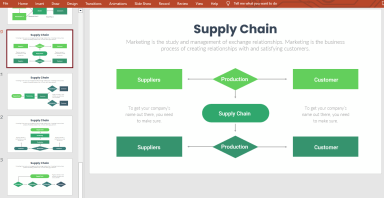
Originally published: 30/10/2023 09:47
Publication number: ELQ-25945-1
View all versions & Certificate
Publication number: ELQ-25945-1
View all versions & Certificate

Supply Chain Analysis
This involves the assessment and optimization of supply chain activities, from sourcing raw materials to delivering products or services to end customers.
Description
It aims to enhance the efficiency, effectiveness, and overall performance of the supply chain, resulting in cost reduction, improved quality, and increased customer satisfaction. Here are the key aspects and steps involved in supply chain analysis:
Mapping the Supply Chain:
Begin by creating a detailed map of your supply chain, including all the processes, suppliers, intermediaries, and logistics involved in the flow of goods or services from source to end customer.
Identifying Key Components:
Identify critical components of your supply chain, such as suppliers, transportation, inventory management, distribution, and information systems.
Cost Analysis:
Examine the costs associated with each component of the supply chain. This includes procurement costs, transportation costs, holding costs, and operating costs.
Performance Metrics:
Define key performance indicators (KPIs) to measure the effectiveness and efficiency of the supply chain. Common KPIs include on-time delivery, lead times, inventory turnover, and order fulfillment rates.
Risk Assessment:
Identify potential risks and vulnerabilities within the supply chain, such as geopolitical, natural disasters, or disruptions in the supplier network. Develop risk mitigation strategies.
Supplier Evaluation:
Assess the performance and reliability of your suppliers. Consider factors like quality, consistency, lead times, and their ability to meet demand.
Inventory Management:
Analyze your inventory management practices. Evaluate stock levels, turnover rates, and carrying costs. Aim to reduce excess inventory while ensuring product availability.
Demand Forecasting:
Implement demand forecasting methods to better align supply with actual demand, reducing the risk of overstock or understock situations.
Technology and Automation:
Explore opportunities for technology and automation, such as using supply chain management software, RFID tracking, and IoT devices to improve visibility and control.
Sustainability and Environmental Impact:
Consider sustainability in your supply chain, including the environmental and social impact of your operations. This may include responsible sourcing, energy-efficient transportation, and waste reduction.
Continuous Improvement:
Supply chain analysis is an ongoing process. Continuously monitor and assess your supply chain, making adjustments and improvements as necessary.
The goal of supply chain analysis is to optimize the flow of products or services while minimizing costs, reducing lead times, and ensuring high-quality outcomes. A well-executed supply chain analysis can lead to a competitive advantage by improving operational efficiency and customer satisfaction.
It aims to enhance the efficiency, effectiveness, and overall performance of the supply chain, resulting in cost reduction, improved quality, and increased customer satisfaction. Here are the key aspects and steps involved in supply chain analysis:
Mapping the Supply Chain:
Begin by creating a detailed map of your supply chain, including all the processes, suppliers, intermediaries, and logistics involved in the flow of goods or services from source to end customer.
Identifying Key Components:
Identify critical components of your supply chain, such as suppliers, transportation, inventory management, distribution, and information systems.
Cost Analysis:
Examine the costs associated with each component of the supply chain. This includes procurement costs, transportation costs, holding costs, and operating costs.
Performance Metrics:
Define key performance indicators (KPIs) to measure the effectiveness and efficiency of the supply chain. Common KPIs include on-time delivery, lead times, inventory turnover, and order fulfillment rates.
Risk Assessment:
Identify potential risks and vulnerabilities within the supply chain, such as geopolitical, natural disasters, or disruptions in the supplier network. Develop risk mitigation strategies.
Supplier Evaluation:
Assess the performance and reliability of your suppliers. Consider factors like quality, consistency, lead times, and their ability to meet demand.
Inventory Management:
Analyze your inventory management practices. Evaluate stock levels, turnover rates, and carrying costs. Aim to reduce excess inventory while ensuring product availability.
Demand Forecasting:
Implement demand forecasting methods to better align supply with actual demand, reducing the risk of overstock or understock situations.
Technology and Automation:
Explore opportunities for technology and automation, such as using supply chain management software, RFID tracking, and IoT devices to improve visibility and control.
Sustainability and Environmental Impact:
Consider sustainability in your supply chain, including the environmental and social impact of your operations. This may include responsible sourcing, energy-efficient transportation, and waste reduction.
Continuous Improvement:
Supply chain analysis is an ongoing process. Continuously monitor and assess your supply chain, making adjustments and improvements as necessary.
The goal of supply chain analysis is to optimize the flow of products or services while minimizing costs, reducing lead times, and ensuring high-quality outcomes. A well-executed supply chain analysis can lead to a competitive advantage by improving operational efficiency and customer satisfaction.
This Best Practice includes
23 PowerPoint Slides




